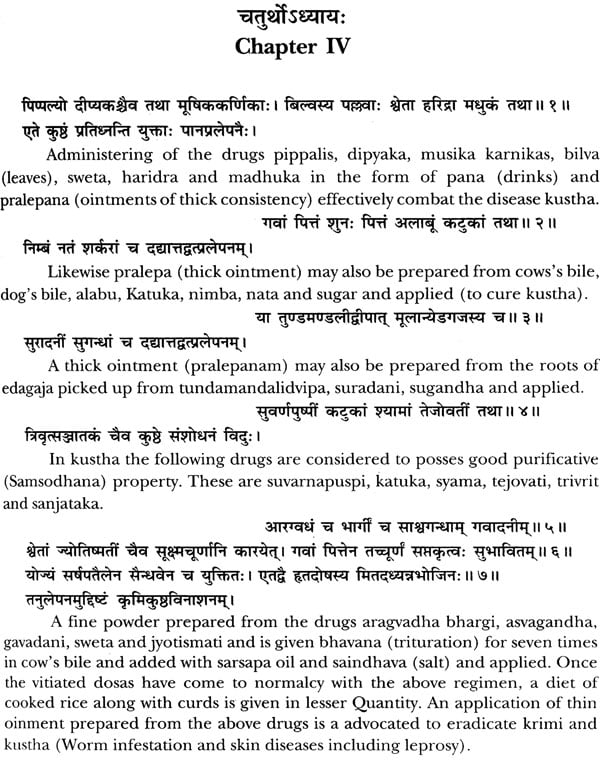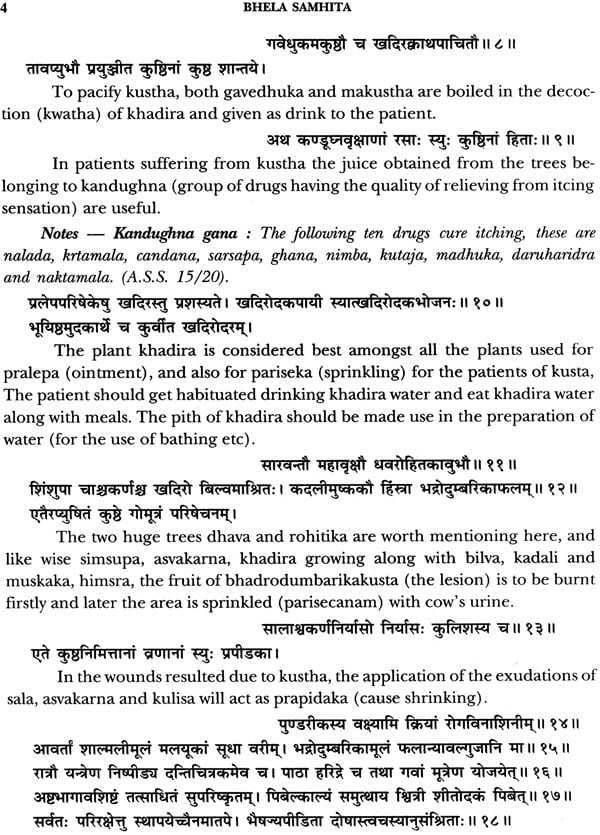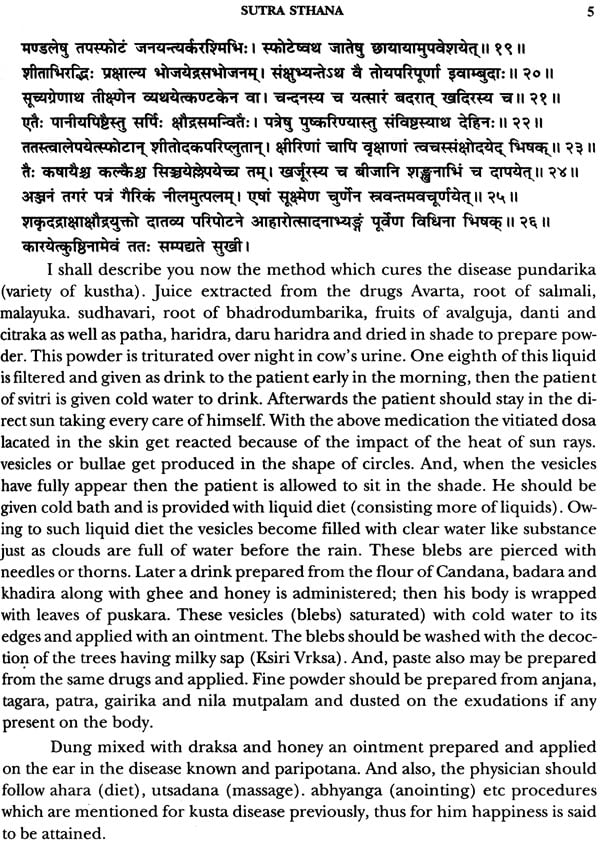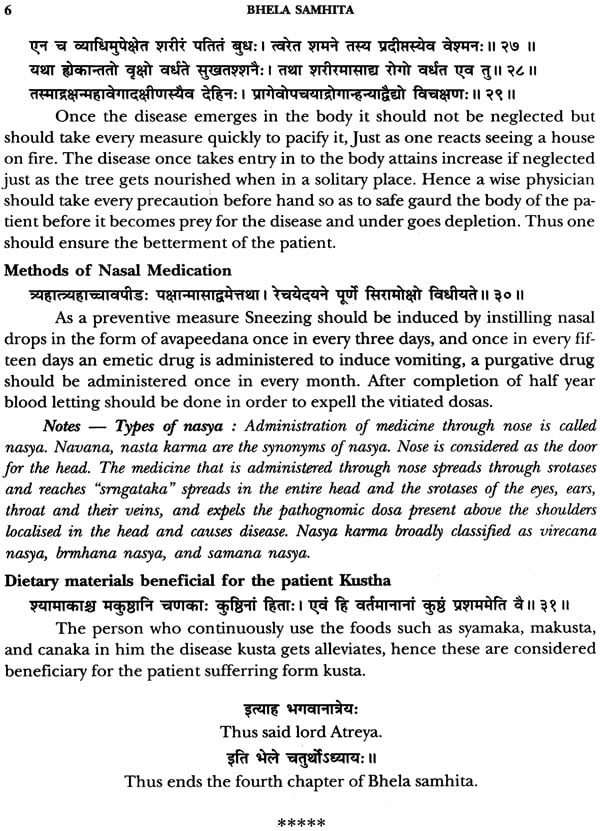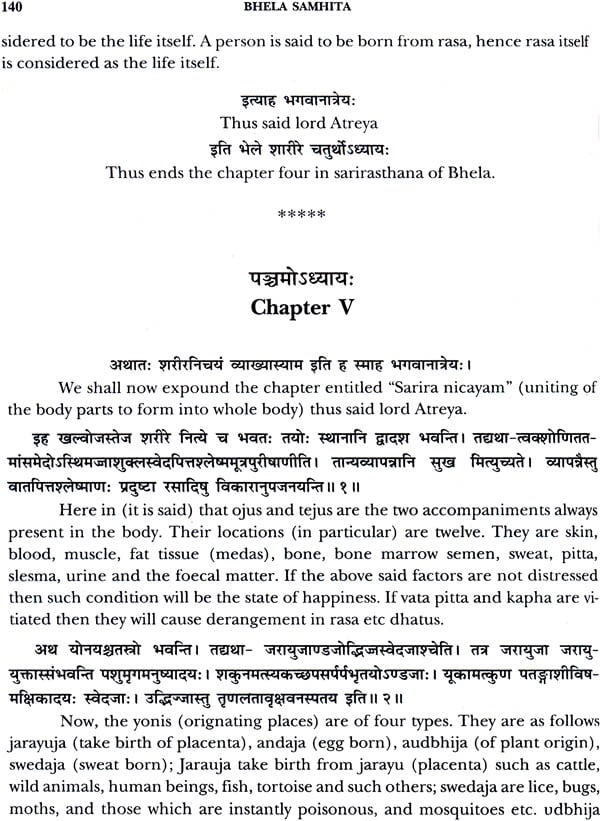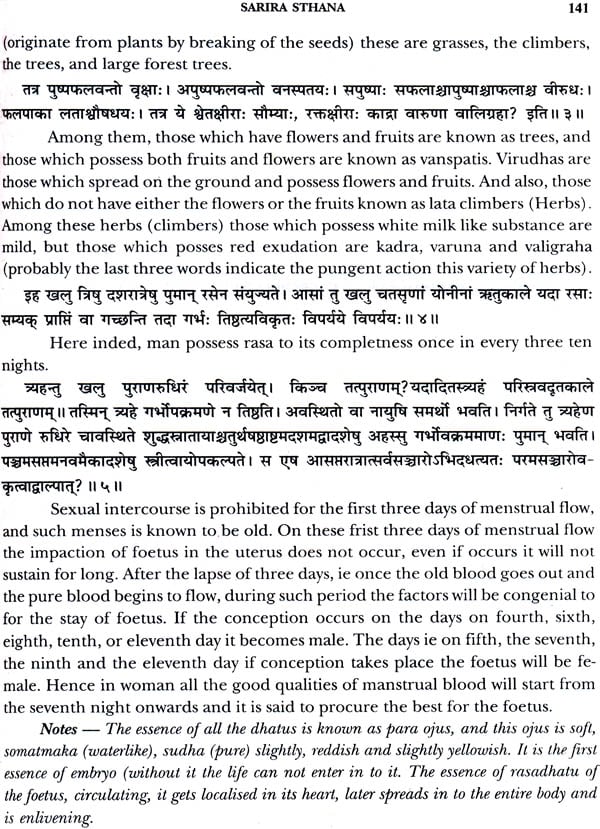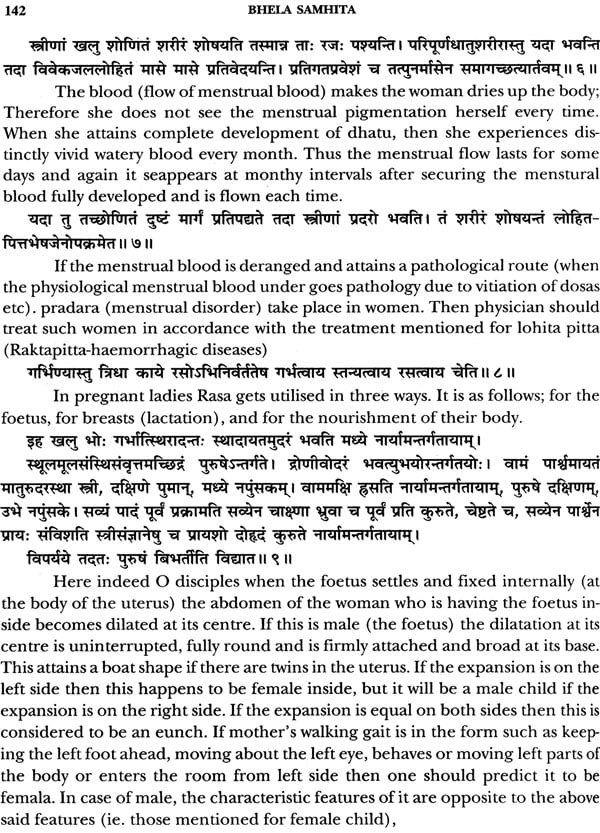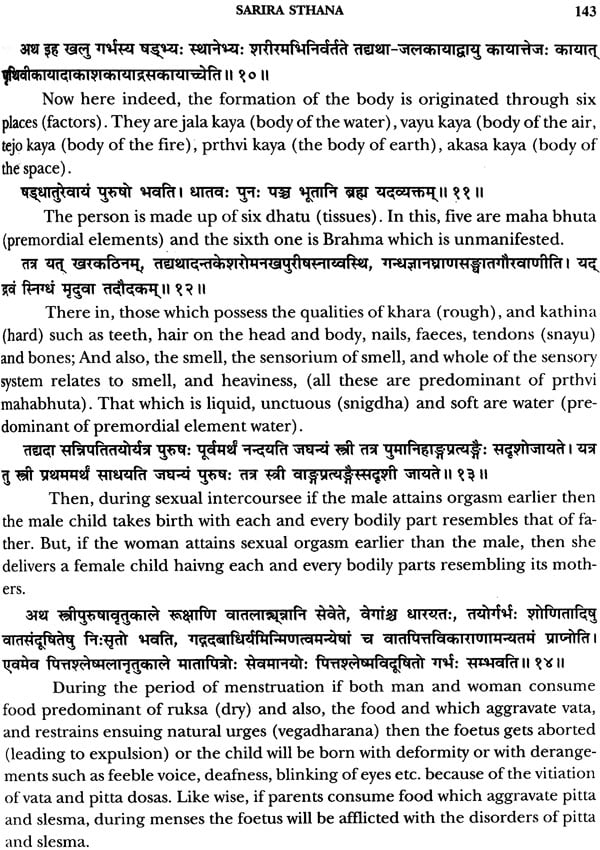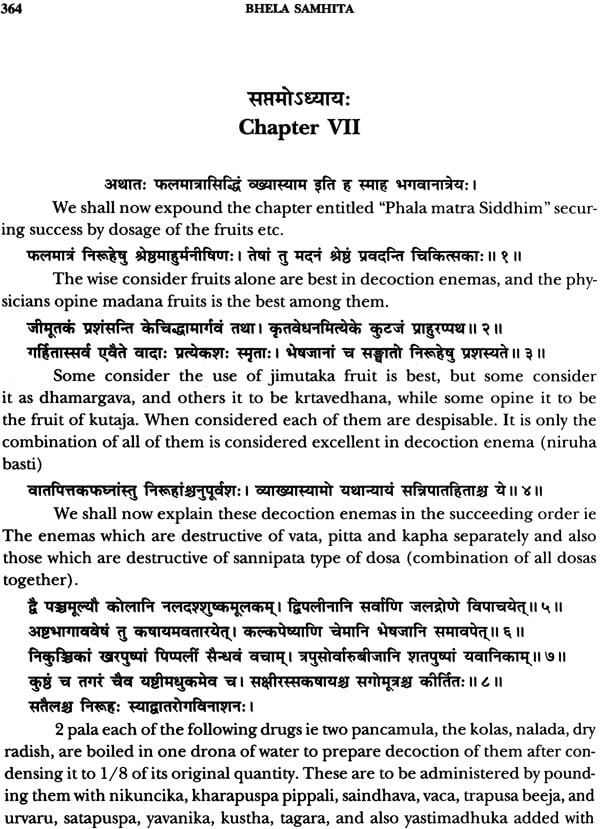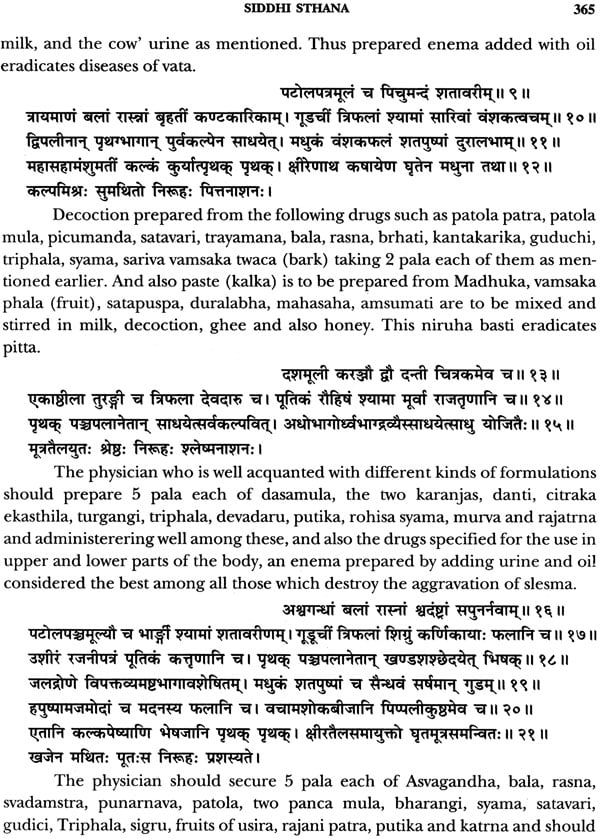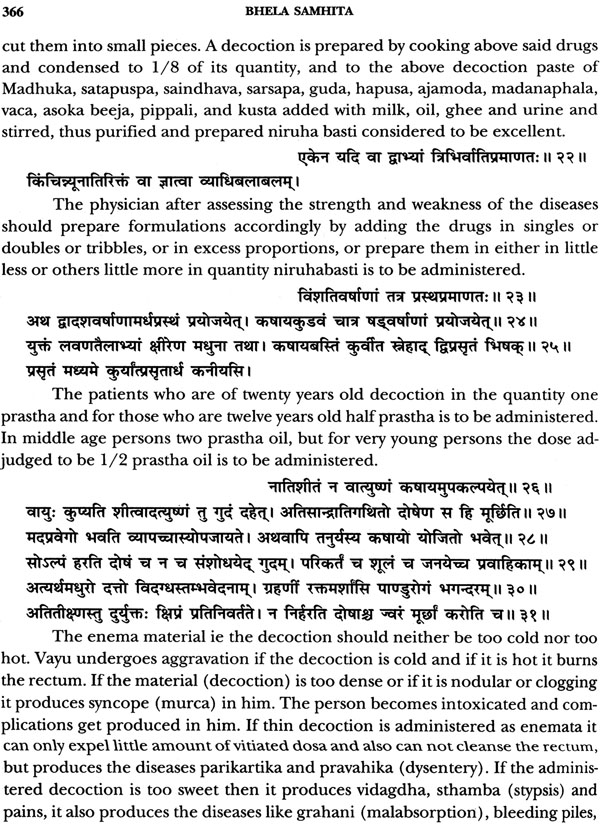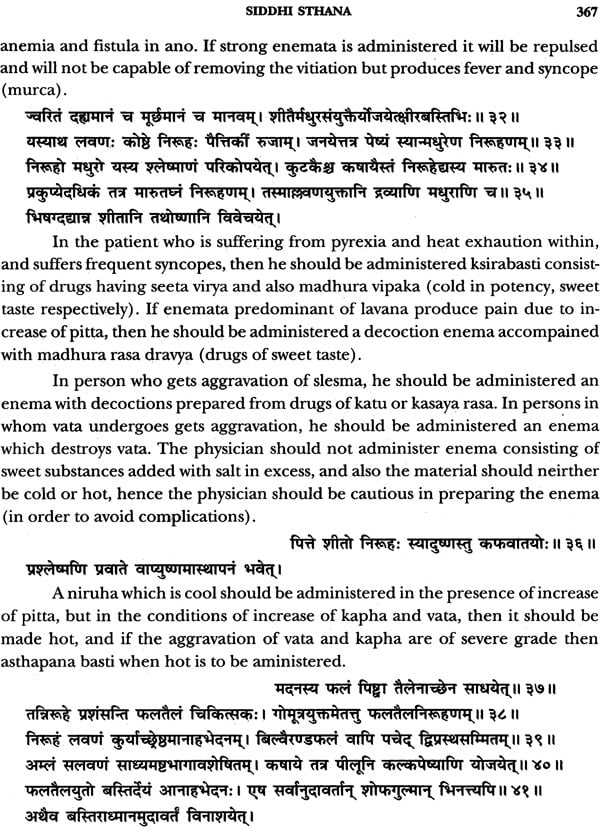
Bhela – Samhita (Text with English Commentary)
Book Specification
| Item Code: | IHL563 |
| Author: | Dr. P. Srinivasa Rao |
| Publisher: | Chowkhamba Krishnadas Academy |
| Language: | English |
| Edition: | 2010 |
| ISBN: | 978812180291 |
| Pages: | 398 |
| Cover: | Hardcover |
| Other Details | 10.0 inch X 7.5 inch |
| Weight | 770 gm |
Book Description
About the Book
Bhela Samhita written by Bhela carya one of the oldest Samhitas belonging to the contemporary time of Agnivesa the writer of the Agnivesa Samhita Bhela Carya one among the six disciples of Punarvasu Atreya. It is described by Burnell in his catalogue of manuscripts under 107 73. A palm leaf manuscript of Bhela Samhita composed in Sanskrit language but written in Telugu script was first found in the palace library, Tanjore. The unique manuscript of this ancient treatise was first published by the Calcutta University in 1921 as Volume VI of the Journal of Department of letters. This great treatise though at some places incomplete, is not known to have been redacted or condensed from the original tantra into smaller Samhita, with the benefit that although it had been dormant in the past ages it has sustained its originality. Bhela Samhita divided as follows- Nidana Sthana, Vimana Sthana, Sarirasthana, Indriyasthana, Cikitsasthana, Kalpasthana and Siddhisthana, Bhela is distinct in explaining vividly about the local food habits and specificity in disease prevalence pertaining to them. Again Bhela is distinct in explaining different symptoms emerge in Dhatus owing to the vitiation of pitta, deranged pregnancy also with its peculiar consequence, and classifying many diseases as Karmaja and also such other. Thus Bhela has advanced his own ideas and thrown light on specific flora fauna, customs, disease prevalence, natural history etc., suggestive of additions and improvements as an yield of his talented genius.
Bhela samhita written by Bhelacarya is one of the oldest Ayurvedic Samhita. He is one of the six disciples of punarvasu Atreya. Despite the commonness among the six individual treatises, Bhela has advanced his own ideas with special reference to flora, fauna, customs, prevalence of diseases etc., particularly of gandharadesa, which is considered as modern Rajasthan of Gujarat. Extensive literary research on these Samhitas is being conducted, specially at TMSSM library Thanjavur. We find several quotations from Bhela are referred by later commentators and writers of Ayurveda, but they are unable to trace in the available manuscript. A concentrated study of this samhita gives us an impression that he gave due importance to Daivavyapasraya cikitsa and this fact gains support by his presenting several diseases as karmaja. He is distinct in specifying the location of Jatharagni in surya mandala and also of its various sizes depending on the nature of bodies. He expresses contradictory opinion when compared to other samhitas with respect to the action of water before and-after meals, and also mentioned the utility of cold water after the process of sudation (sweda kriya). This valuable manuscript is missing in some of the chapters, and also in some chapters initial slokas are missing, and in some chapters concluding slokas are missing. Unlike Agnivesa Samhita, Bhela Samhita did not acquire fame, popularity and propagation in the ages to follow, but till the recent years it is not been redacted or no one has ever written commentaries on it but with the benefit that it has indirectly helped to sustain it’s originality.
This text has been translated into simple form of English for easy comprehension of the student. I hope it will kindle interest for study of classical texts in the students and others as well.
I am thankful to my student Miss. A. Anjali (final B.A.M.S.) for undertaking the work of proof reading.
I acknowledge with sincere thanks to the proprietor and staff of M/ s Chowkhambha Krishnadas Academy, Varanasi, the reputed publishers of Ayurvedic texts for including this book in their Ayurveda series.
Bhela Samhita one of the oldest Ayurvedic Samhitas, since Bhela has been I accepted as one of the six disciples of punarvasu Atreya. I-le was thus contemporary of Agnivesa. Burnell also puts him in the time of Agnivesa. The six disciples enumerated as Agnivesa, Bhela, Jatukarna, Parasara, Harita and Ksarapani (Ca. Su. 1). After receiving comprehensive knowledge of Ayurveda from their preceptor revered Atreya, independently wrote a compendium of his own on the Ayurveda, and such knowledge which passed from mouth to mouth could be preserved only in the form of handwritten manuscripts, not easily available to every one.
A concentrated study is now being undertaken by various individuals and institutions for the collection and study of these manuscripts which are scattered. A critical study reveals that despite the commonness, they must have advanced their own ideas, and thrown light on the specific flora, fauna, customs, and diseases. And also, described about the folk, sociological facts, natural history etc.
A palm leaf manuscript of Bhela Samhita, composed in Sanskrit language, but written in Telugu script was first found in the palace library, Tanjore and de- scribed by Burnell in his catalogue of Sanskrit manuscripts under no 10773.
This manuscript also though the best, is missing in some of the sections in the beginning and also at the end. As such the manuscript available reveals its existence from the middle of the fourth chapter of the sutrasthana, and ends abruptly in the middle of the eighth chapter of the siddhi sthana. In this available sections also some of the chapters are complete and others are incomplete. There is a manuscript in the library of India office, London also, but it is learnt that it is none but a copy of the same Thanjavur manuscript. Thus this manuscript has been the source material for the research scholars on Bhela Samhita. In 1905 Hornle has translated and it has been copied in to Nagri script also. Bhela Samhita do not show any evidence of Buddhist influence, since the rituals S etc., show to follow Vedic pattern. There is another paper manuscript of Bhela Samhita in the manuscript library Trivandrum. This is of 339 foolscape pages and it is mentioned in the manuscript itself that it is the copy of the Tanjore manuscript.
The Calcutta University has first published this unique ancient treatise in the year 1921. The book was again recently published by the Chaukhamba Bharati Academy, Varanasi, in 1959. The text was edited by Sri Girija dayal shukla. Mr. Ghananand pant, opines that Bhela belonged to Marubhumi (barren area) of Rajasthan on the basis that in the text it is mentioned several times while describing about dietetics etc., milk of camel and grains grown on dry and Waterless regions. The text of Bhela Samhita reveals that there is frequent occurrence of unpaninian forms this leads to place him prior to Panini, who belongs to 7th century B.C. Panini in his writings did not mention about Bhela but refers to Jatukarna and Parasara etc. in Gargadigana. Since Bhela is one of the colleague disciples of Agnivesa, Jatukarna, parasara etc., This reference is equally applicable to Bhela also since Bhelacarya presented his text with the equal number of sthanas as well as adhyayas like those of the samhita of Agnivesa, and that many adhyaya even bear similar nominclature makes us believe that Bhela Samhita is also as old as may be Agnivesa Samhita. Burnell establishes Bhela be- longing to the olden Gandhara region. Asvagosha mentions Atreya as a com- poser of medical treatise and this suggest that a work of Atreya was popular in 1st century B.C. The Bower manuscript or Navanitakam quotes from the work of Bhela. Therefore, Bhela should have lived between second century A.D., and sixth century B.C.
Rajarshi Nagnajit, who is mentioned in Bhela Samhita and a contempory of Bhela is referred in Shatapatha Brahmana and Aitereya Brahmana. This indicates that Atreya and his disciple Bhela flourished during or anterior to the period of Aranyakas, Brahmanas, sutra and Mahabharata.
Hoernle points out that the ‘Amatisara’ formulae, in the Bower manuscript are quoted not directly from the work of Susruta Samhita, but intermediately through Bhela Samhita. Therefore, this presupposes the existence of Susruta Samhita not only refer’s Samhita by name but also teaches of Susruta’s doctrines regarding gulma disease. Though Agnivesa and Bhela were the disciples of the same persons; but the composition of Agnivesa is more elaborate and in greater detail, while that of Bhela is very concise.
Burnell opines that Vagbhata is very much indebted to Bhela Samhita. Jvara Samuchaya is considered to be 1000 years old refers some verses under the name of Bhela. Yogaratna samucchaya of chandrata refers some verses from Bhela and quotes them. A concentrated study of other Sanskrit medical manuscript and printed texts significantly tells us the region in which Bhela Samhita was read widely and cited as authority.
While describing about Jatharagni Bhela mentions that it exists in the Surya mandala, which is in the somamandala, in the umblical region. He also gives measure of this Jatharagni. He states that the physician, who treats the disorders of this digestive fire is called Kayachikitsa.
In all Samhitas pitta is categorised in to five types, one of it is Alocaka pitta. But Bhela again subdivides this in to two, namely Chakshu vaiseshika and Buddhivaisesika.
In the chapter Janapada Vibhaktiya, Bhela describes the diseases which occur most commonly in different regions of the country, due to the habits, diet etc. of the people of that particular region, this is not mentioned in Caraka Samhita; but the last chapter by name ‘Deshasatmyadhyaya’ in Kashyapa samhita describes about this subject.
Bhela gives much importance to daiva vyapasraya chikitsa. He considers several diseases as karmaja. Unlike the others Bhela carya classifies 18 kusthas in to two divisions having nine as dosaja and other nine as Karmaja, and includes visaja kusta and switra also.
Bhelacarya advocates a ghee coating in the mouth prior to prayogika dhumapana to have better tolerance. He is distinct in advising to dry palms by exposing them over to the fire after meals (S.U. 6/45). All other acaryas of Ayurveda explain three stages of digestion as three avasthapaka, none of them speaks of udgara. Bhelacarya mention the three different types of udgara occur during the time of digestion. Again Bhela is distinct explaining various symptoms developed in dhatus due to morbidity of pitta. S.U. 25/25.
Bhela Samhita differs in the order and sequence of administration of three myrobalanic components of Triphala. Bhela while describing matrasitiya advocates amalaki to be taken before meal and haritaki after meal and vibhitaki after digestion, and also gives pharmacological reasoning of this order. Likewise there appears contradiction between Bhela and later samhitas with regards to the action of water taken before, with or after meals. Similarly other acaryas have prohibited the contact and use of cold water but Bhelacarya advocates the use of cold water while describing kutisweda to mitigate the exhaution caused by sudation S.U. 2/30, while the preceptor has prohibited the combination of fish and milk for intake, Bhela permits this except the chilichima fish.
Though number of references of Bhela appeared in the following books such as Hemadri Vyakhya on A.H.Si1. 7/55 and A.H. Sutra 7/65, Chakrapani Vyakhya on Cha. Ch. 3/275, Tatwacandrika, Chikitsa Kalikavivruti Dalhana commentary on S.Su. 33-29; but the same are not visible in this manuscript under editing, thus giving an impression that the original treatise of Bhela is missing. However, due to following reasons this Bhela Samhita is being neglected. l. Frequent occurance of unpaninian forms and other mistakes of grammatical nature of the text. 2. Inadequacy of the philosophical basements in the enumeration of theories. Apart from agreeing in major with the common structural form of the Agnivesa Samhita, Bhela has put forth number of new ideas, some times contradicted important theories. Thus new ideas and contradictory statements may be taken as suggestive of additions and improvements as an yield of his talented genius.
| Preface | ||
| Introduction | ||
| 1. Sutra Sthana | ||
| Ch. I-III | Missing | |
| Ch. IV | Kustha Cikitsa | 3 |
| Ch. V | Athatyasitiyam | 7 |
| Ch. VI | Navegandharaniyam | 10 |
| Ch. VII | Indriyopakramaniyam | 17 |
| Ch. VIII | Matrasitiyam | 19 |
| Ch. IX | Catushpada Bhishagjitiyam | 23 |
| Ch. X | Amapradoshiyam | 28 |
| Ch. XI | Samasana Parighaniyam | 31 |
| Ch. XII | Atreya Khnda Kapyeeyam | 34 |
| Ch. XIII | Janapada Vibhakteeyam | 37 |
| Ch. XIV | Cikitsa Prabritiyam | 39 |
| Ch. XV | Trisrishaniyam | 42 |
| Ch. XVI | Vatakalakaliyam | 44 |
| Ch. XVII | Dasapranayataniyam | 46 |
| Ch. XVIII | Annapanaraksiyam | 48 |
| Ch. XIX | Vidhi Sonitiyam | 52 |
| Ch. XX | Urdhwa Dasa Maha Muliyam | 54 |
| Ch. XXI | Asthapana, Anuvasana in Vataroga | 56 |
| Ch. XXII | Swedadhyaya | 58 |
| Ch. XXIII | Gadha Purisiyam | 63 |
| Ch. XXIV | Missing | |
| Ch. XXV | Rtu Vibhagiyam | 64 |
| Ch. XXVI | Astodariyam | 69 |
| Ch. XXVII | Annapana Vidhiyam | 74 |
| Ch. XXVIII | Bhojana Vidhiyam | 79 |
| 2. Nidana Sthana | ||
| Ch. I | Missing | |
| Ch. II | Ksayam | 89 |
| Ch. III | Gulma Nidanam | 92 |
| Ch. IV | Kasa Nidanam | 95 |
| Ch. V | Kusta Nidanam | 97 |
| Ch. VI | Prameha Nidanam | 100 |
| Ch. VII | Unmada Nidanam | 102 |
| Ch. VIII | Apasmara Nidanam | 104 |
| 3. Vimana Sthana | ||
| Ch. I | Rasa Vimanam | 109 |
| Ch. II | Missing | |
| Ch. III | Durbalagni | 113 |
| Ch. IV | Roga Prakrti Vinischayam | 116 |
| Ch. V | Vyadhita Rupiyam | 120 |
| Ch. VI | Rtu Vimanam | 121 |
| 4. Sarira Sthana | ||
| Ch. I | Missing | |
| Ch. II | Kseena Dhatu | 127 |
| Ch. III | Asamana Gotriyam | 129 |
| Ch. IV | Purusa Nicayam Sariram | 132 |
| Ch. V | Sarira Nicayam | 140 |
| Ch. VI | Khuddika Garbhava Krantim | 146 |
| Ch. VII | Sarira Sankhya Sariram | 148 |
| Ch. VIII | Jati Sutriyam | 152 |
| 5. Indriya Sthana | ||
| Ch. I | Ayurlakshanendriyam | 159 |
| Ch. II | Swastyana Mindriyam | 161 |
| Ch. III | Mumursu Lakshana | 162 |
| Ch. IV | Sadyomarana Mindriyam | 163 |
| Ch. V | Syaviyam | 165 |
| Ch. VI | Purva Rupiyam | 167 |
| Ch. VII | Indriyanika Mindriyam | 169 |
| Ch.VIII | Dutadhyaya | 171 |
| Ch. IX | Gomaya Curna | 173 |
| Ch. X | Caya dhyaya | 176 |
| Ch. XI | Pusphiyam | 177 |
| Ch. XII | Avakcitiyam | 179 |
| 6. Cikitsa Sthana | ||
| Ch. I | Ekadasa Sarpiskam | 185 |
| Ch. II | Visamajwara Cikitsitam | 191 |
| Ch. III | Raktapitta Cikitsitam | 195 |
| Ch. IV | Yaksma Cikitsitam | 197 |
| Ch. V | Gulma Cikitsitam | 206 |
| Ch. VI | Kustha Cikitsitam | 211 |
| Ch. VII | Prameha | 218 |
| Ch. VIII | Unmada Cikitsa | 222 |
| Ch. IX | Apasmara Cikitsa | 226 |
| Ch. X | Atisara Cikitsa | 227 |
| Ch. XI | Grahani Cikitsa | 236 |
| Ch. XII | Mutra Krchra Cikitsa | 238 |
| Ch. XIII | Udara Cikitsa | 240 |
| Ch. XIV | Urusthamba Cikitsa | 246 |
| Ch. XV | Visarpa Vatasonitam | 249 |
| Ch. XVI | Arsas Cikitsa | 254 |
| Ch. XVII | Swayathu Cikitsa | 263 |
| Ch. XVIII | Udavarta Cikitsa | 268 |
| Ch. XIX | Hrdroga Cikitsa | 270 |
| Ch. XX | Kasa Cikitsa | 273 |
| Ch. XXI | Siroroga Cikitsa | 278 |
| Ch. XXII | Ajeerna | 285 |
| Ch. XXIII | Nidra and Murca | 287 |
| Ch. XXIV | Vatavyadhi | 289 |
| Ch. XXV | Pliha Halimaka Cikitsa | 295 |
| Ch. XXVI | Apatantaka Cikitsa | 297 |
| Ch. XXVII | Vrana Cikitsa | 301 |
| Ch. XXVIII | Panatyaya Cikitsa | 303 |
| 7. Kalpa Sthana | ||
| Ch. I | Madana Kalpam | 317 |
| Ch. II | Missing | |
| Ch. III | Iksvaku Kalpam | 319 |
| Ch. IV | Dhamargava Kalpam | 320 |
| Ch. V | Kutaja Kalpam | 323 |
| Ch. VI | Caturanguleyam Kalpam | 324 |
| Ch. VII | Danti phala Kalpam | 327 |
| Ch. VIII | Sankhini Kalpam | 328 |
| Ch. IX | Syama Trvrt Kalpam | 331 |
| 8. Siddhi Sthana | ||
| Ch. I | Vamana etc. Samsodhana | 339 |
| Ch. II | Sirovirecana | 343 |
| Ch. III | Missing | |
| Ch. IV | Dasa Vyapadiyam Vamana Virecana Siddhi | 347 |
| Ch. V | Basti Matriya Siddhi | 355 |
| Ch. VI | Upa Kalpa Siddhi | 359 |
| Ch. VII | Phala Matra Siddhi | 364 |
| Ch. VIII | Dasa Vyapadamasthapana Manuvasanasiddhi | 369 |
| Bibliography | 379 | |
| Appendix | 380 |
